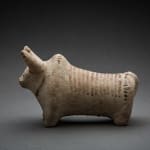Group of Painted Zebu Bulls, 2600 BCE - 1900 BCE
Terracotta
PF.7021
Further images
Set of 9 bull figurines, modelled in terracotta and painted in darker pigment over the snout, the horns and the legs. Terracotta figurines such as these ones have been unearthed...
Set of 9 bull figurines, modelled in terracotta and painted in darker pigment over the snout, the horns and the legs.
Terracotta figurines such as these ones have been unearthed at Mohenjo-daro and Harappa, suggesting a commonality of style and purpose throughout the Indus Valley during the mature Harappan period (ca. 2600-2450 BCE). Like many figurines datable to this period, the front and back legs are joined together. In one excavated example from Chanu-daro a hole was poked in the belly, indicating that it would have been attached to a stick for use as a puppet or a small standard of the kind carried in the processions depicted on some seals. In others a hole is visible on the back rather than the belly, thus suggesting a different use, perhaps as musical instruments of some sort.
For a comparable example see: J.Aruz ed, Art of the Ancient Cities, 2003: no.276, p.390. J.Kenoyer, Ancient Cities of the Indus Valley Civilization, 1998.
Terracotta figurines such as these ones have been unearthed at Mohenjo-daro and Harappa, suggesting a commonality of style and purpose throughout the Indus Valley during the mature Harappan period (ca. 2600-2450 BCE). Like many figurines datable to this period, the front and back legs are joined together. In one excavated example from Chanu-daro a hole was poked in the belly, indicating that it would have been attached to a stick for use as a puppet or a small standard of the kind carried in the processions depicted on some seals. In others a hole is visible on the back rather than the belly, thus suggesting a different use, perhaps as musical instruments of some sort.
For a comparable example see: J.Aruz ed, Art of the Ancient Cities, 2003: no.276, p.390. J.Kenoyer, Ancient Cities of the Indus Valley Civilization, 1998.







